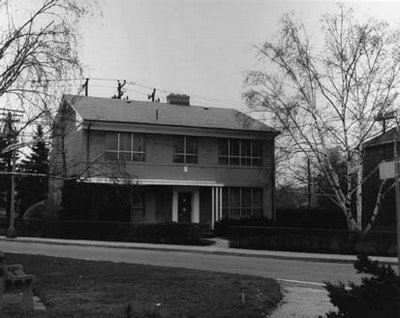
In 1987, Canadian photographer Robin Collyer began documenting houses that aren’t houses at all – they’re architecturally-disguised electrical substations, complete with windows, blinds, and bourgeois landscaping.
“During the 1950s and 1960s,” Collyer explains in a recent issue of Cabinet Magazine, “the Hydro-Electric public utilities in the metropolitan region of Toronto built structures known as ‘Bungalow-Style Substations.’ These stations, which have transforming and switching functions, were constructed in a manner that mimics the style and character of the different neighborhoods.”
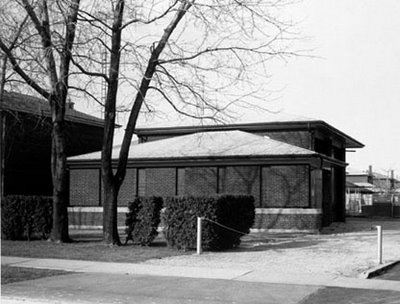
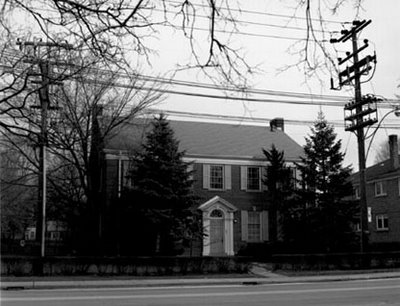
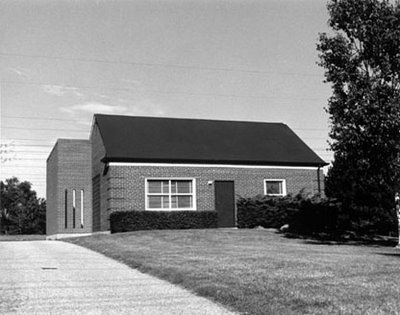
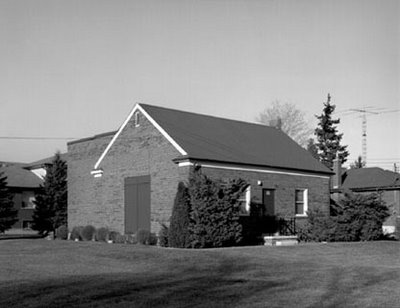
[Images: Robin Collyer].
Simulacra meant to reflect how it looks to be domestic and Canadian, “there are about 100 of these structures located on residential streets in the central and the suburban parts of the greater Toronto area.” Pictured here are only five of them. So if you live in suburban Toronto and your neighbor’s house is humming – perhaps now you know what’s really going on inside.
Meanwhile, the address 555 Spadina – i.e. the third image, above – shows up in this list of 322 properties owned by the city of Toronto. If anyone out there knows something about the other 321 buildings, be in touch!
(Note: These images come courtesy of the Centre for Contemporary Canadian Art – with the exception of the first, which appeared in Cabinet Magazine).
There is one of the houses on the north side of Eglinton west of Mt. Pleasant. The funny thing about this particular house, however, is that although it was constructed to blend into the neighbourhood, the surrounding houses have since been demolished and replaced by apartment buildings, and so it now sticks out like the sore thumb Toronto Hydro was trying to avoid.
How interesting and hilarious! I have located a few of these electric transformer/substation “houses” in Hamilton, Ontario as well if you are interested! The addresses are 300 Parkdale Avenue North, 2343 King Street East, and 1431 Barton Street East. What a fascinating topic!
I remember one year my dad took us to one of these houses (albeit in the Niagara Region, not Toronto) for Halloween. While it was cruel, it was also hilarious.
I keep imagining nuclear families of transformers, one in each bedroom and two in the master suite. Where do they go to church? What schools? What does breakfast consist of for a transformer? Maybe Pancakes with PCBs
In some places these are used to “house” telephone equipment. The local telco actually pays someone to “live” there on Hallowe’en to hand out candy!
Not just a Canadian phenom-
Down in Washington DC the local utils have several “houses” and a few small
retail bulding transformer substations
There is one down the street from me in Oakville at elmhurst and devon road. Not sure if it’s too far out of Toronto to be one of the missing from the list. It seems to end in Etobicoke.
new york city does something similar, only instead of houses, they’re fake apartment buildings.
Interesting!
i can think of a few in nyc that house telephone equipment, but they don’t really blend in since they don’t have windows….i’m guessing that they don’t need these huge buildings anymore since technology is getting better – what are they gonna do with huge windowless buildings?
London, of course, has 23/24 Leinster Gardens (mentioned toward the bottom of that link). It’s really a “dummy house,” or a ventilation shaft for the Tube. You can read more about it at Urban75.
So there’s no interior, there’s only a connection to the underworld.
There’s one on Avenue Rd., East side, south of Wilson. Ugly red bungalow.
I used to live just 3 houses down from one of the pictures “homes” not noisy or humming at all. Never would have guessed what was really going on inside the quaint looking “house”
Millwood West of Bayview
I remember one from my childhood in Willowdale. Using google maps i’ve located it as, “5 wyvern rd toronto on.” That is, if you look there the dart is pointing at the substation.
-cheers
As a response to what will become of these buildings as technology decreases the space needed to house the equipment, some of the telco’s where I live have started leasing the space for co-lo servers.
There is also one of these houses in Windsor, located on Bloomfield Road (West Side). It must have been upgraded at some point, because additional transformers were located in the back yard, and it was subsequently surrounded with a high fence.
There is one of these houses located on Wisconsin Avenue in Washington DC – almost directly across from the former Soviet Embassy. I always suspected that it was operating in some sort of surveillance capacity during the cold war.
640 Millwood (Toronto) and 27 Wingrove Hill (Etobicoke) are both transformer houses.
Thank you very much for your contribution! I have located a few of these electric transformer/substation “houses” in Hamilton, Ontario as well if you are interested! The addresses are 300 Parkdale Avenue North, 2343 King Street East, and 1431 Barton Street East. What a fascinating topic!
There was an article about these in the Washington Post >10 years ago. It seems that technology has reduced the neccessity for these so one of them was sold and then converted into a SFH. Apparently because they had to build the interior around the transformer platforms there was a bizzare interior arrangement, and going into most rooms involved going up or down a step or two.
Wow, those last two are really obvious. I see these all the time, working for the telco as I do, I’m usually looking for hidden buildings and my eyes are sort of tuned for this stuff now.
Their blunder on the second one was the chain across the driveway. Bzzt, cover blown!
Anyway, as for the telecom buildings: Equipment density has improved in recent years, but so has power consumption. So while a five-story building might’ve been four floors of equipment and batteries in the basement, now it’s one floor of equipment with batteries in the basement, and the air conditioners are still operating close to their limit because that one floor is burning through so many watts. So in many cases, that extra space really can’t be used for anything but storage.
There is an office building here in LA called One Wilshire that is completely given over to the physical part of the internet. It’s pretty big, maybe 20 stories. No office workers, just an army of net guys and an infinitude of servers and cable.
Next block over from where I live they are converting a former windowless storage building into ‘lofts’ It is done by sawing big holes in the outer walls and jack-hammering, ALL DAY.
How exciting and interesting this is!!!
Agreed! I have located a few of these electric transformer/substation “houses” in Hamilton, Ontario as well if you are interested! The addresses are 300 Parkdale Avenue North, 2343 King Street East, and 1431 Barton Street East. What a fascinating topic!
at this time of the war games that’s being played out through out the world, I think that some type of information should be left out of the veiwing eye, as giving key maps to places that could harm your neighborhood, but some people feel they have to tell everything they know, it make’s them feel important, during WWII, signs that read “hush the emeny could be can hear you”
Anonymous, are you suggesting that I’ve endangered Canadian national security by putting these photos on my blog? Perhaps you should contact the city of Toronto and tell them to remove the addresses of their 322 metropolitan properties, many of which are power substations.
And, Tim – or anyone, really – there’s a great article that mentions One Wilshire: Centripetal City by Kazys Varnelis. Worth reading. At the very least read the first paragraph, which I’ve cut and pasted here:
“On July 19, 2001, a train shipping hydrochloric acid, computer paper, wood-pulp bales and other items from North Carolina to New Jersey derails in a tunnel under downtown Baltimore. Later estimated to have reached 1,500 degrees, the ensuing fire is hot enough to make the boxcars glow. A toxic cloud forces the evacuation of several city blocks. By its second day, the blaze melts a pipe containing fiber-optic lines laid along the railroad right-of-way, disrupting telecommunications traffic on a critical New York-Miami axis. Cell phones in suburban Maryland fail. The New York–based Hearst Corporation loses its email and the ability to update its web pages. Worldcom, PSINet, and Abovenet report problems. Slowdowns are seen as far away as Atlanta, Seattle, and Los Angeles, and the American embassy in Lusaka, Zambia loses all contact with Washington.”
I wonder in any would be theives got an unusual suprise when they went to rob the unpopulated house?
I bet they would be electrocuted. The signs all say “high voltage”, “danger” and “keep out.”
There is also one on Oriole Road just south of UCC, we snuck in there once and smoked a big joint in their garage, it was dope!
one wilshire acutally only has one floor of telco equipment. i’ve been there… there is only one elevator that goes there.
“444 Logan Avenue” actually points to an occupied old-folks apartment building. What use does such a building has for Toronto Hydro, i dunno.
There are some in Waterloo, ON as well.
Brent, I was going to post exactly that same house, as I used to live very nearby. This article brings back memories.
If I remember, if you look at that house from the back, the roof is open–only the front of the house has a full roof.
I’ve since transplanted to Florida. Down here, if a house is missing part of its roof, it’s probably not by design.
Incidentally, my brother Pete used to have a friend named Brent. I know it’s a long shot, but…
🙂
looks homo as fuck. fucking canadians
Here on the other side of Canada, in Vancouver, if your neighbor’s house is buzzing with unusual amounts of electric activity, it’s more like that the place is full of sunlamps and marijuana…
thats really perfect.
instead of spending the same amount of money on a concrete block, they sure do rock
There’s one near Midland and Huntingwood out in Scarborough
There’s a bunch in Birmingham and Royal Oak Michigan, I think one on 14 mile between coolidge & woodward Ave.
I know the area there way too well…
Switzerland has an extensive history of hiding military facilities in ordinary-looking structures. A small, two story brick octaginal building next to the route Suisse near Gland in the Canton of Vaud has painted windows with curtains and flower boxes; it is said locally to have (had) an antiaircraft battery inside. A similar but larger apartment building in downtown Geneva reportedly has the same. Other structures such as rocks and even mountains are reported in the Swiss press as having military or medical facilities inside, even aircraft hangers! Military camoflague has a long and honorable tradition. During WWII Boeing Field in Seattle was covered by nets painted to look like city street grids from the air and radio antenna fields near Petaluma, California, were covered with nets painted with cows to look like pastures. Then, there was the Trojan Horse….
“By its second day, the blaze melts a pipe containing fiber-optic lines laid along the railroad right-of-way, disrupting telecommunications traffic on a critical New York-Miami axis.”
It is easy to forget that the net is a physical thing.
There are reportedly at least 2 similar type houses in Brooklyn… one is in Brooklyn Heights the other in flatbush and both are actually entrances for subway workers to get into big underground control rooms. Can’t find a web reference right now, but I’ve read about it several times over the years.
there is a pump station near here that has a fascade of a normal house, the only difference is a razor wire topped 8 foot tall fence that surrounds it :/
There are three (originally four) fake italianate mansions on
Holborn Viaduct. aerial photo
Sigh. aerial photo.
One of the other 321 buildings owned by the City of Toronto (Property 295 – 150 Orton Park Rd) is a substation too. I grew up around the corner from it.
The NY Times ran a story about the brownstone facade a while back. The article was titled: URBAN TACTICS; A Puzzle Tucked Amid the Brownstones. You can usually get to it by searching the Times website, although it is currently (Wed 5:55PM) down.
Bell Canada has a history of the same. In many of the smaller towns the Central Offices (switching stations) look like residential buildings.
This does not occour so much in Toronto where the COs are really old and most are quite huge.
About 50 years ago Boston, Mass. tore down buildings along a strip of land intended for a SW corridor highway. Activists got the highway blocked, then about 30 years ago a subway was put in the dead-zone and part of the route decked over with parks & gardens.
Along the route are a number of false bowfront buildings that were built to match the neighboring, historically notable, structures (largest set of Victorian Rowhouses in NA). They hide electrical substations and ventilation stacks. What gives these dummy buildings away isn’t so much their windows being darker bricks but that all of the bricks are slightly glazed and don’t match the area’s typical dull red bricks.
Oh, and Columbia, Maryland is full of building built to “blend in”. Gas stations look like houses, small malls look from the street like residential buildings, it’s an endlessly exasperating streetscape of suburban inanity, even when it needn’t be. I finally got to the point I’d have friends meet my car off the highway and guide me to their homes through the intentionally landmark-free desert they lived in.
Finally, as to the whole loose-lips-sink-ships business, the locations of transformer substations aren’t any great secret. Indeed that these are ‘obscured’ ones only highlights their small size and relative insignificance. For example it’d be trivial to disrupt the high tension line towers from, say, the Lake Ontario nuclear complexes to Toronto, with much less chance of getting caught and far greater effect.
As to the psychology of those who nervously “shush” anyone they think might somehow compromise their vital bodily fluids – I’m guessing a sad mix of basic ignorance, a lack of creativity in themselves or resepct for it in others, and a good helping of unwarranted bossiness. Yeah – chatting about substations will lead to the “Big “T”” threat…
My mum lied to me!!! We have these houses in London, Ontario. They always seemed to be the most contemporary ones on the street and I thought they rocked. Hey, Mike Brady was the architect for all I knew. I asked mum about them one day driving by one in the 1994 Ford Gran Torino station wagon we had. Ya, it was pimpin’ all right. My mum told me it was a house of ill repute.
Huh?
I guess it makes sense now. I saw a ‘contact in case of emergency’ sign posted at a house years later in my teens. You know, John Hughes movies, Ally Sheedy and that damn sexy dandruff she turned into snow during Breakfast Club. I still do it to this day.
I called the number and asked about getting serviced. They hung up on me. I always wondered why. I was a good boy, sexually frustrated, but I was a good boy.
So it wasn’t a bordello after all? Damn…. my mum lied to me.
hahahaha
There’s one in Ottawa at the corner of Byron Ave. and Hillcrest Ave. too.
I grew up a couple blocks away and it was years before I learned what it really was. 🙂
As mentioned above, there is quite a tradition of making these facilities look like pidgeon towers etc. in Switzerland and southern Germany. There have aslo been some (German-languaged) publications on the them. In fact, I’ve made one myself 🙂
Thanks for posting this! I’m investigating the addresses on the list. I’ve found some interesting houses, some ugly standard looking transformer buildings, and some vacant lots (underground transformers?). I’m organizing a bike tour of them tomorrow evening (Wed Aug 23) if anyone is interested send me an email crazybikerchick ~AT~ gmail
Tanya – How’d the bike tour go? Did you go? Take any pictures…? Find anything cool?
I would rather see the ghastly pylons taken down. They look so “third world”. How is it that we continue to allow lines, particularly those wrist size optical fibre cables and junction boxes, to ruin the skyline
My mother told me that my Grandfather, Harold Bodwell, who worked for Toronto Hydro in the ’20’s and 30’s was given the task of designing substations for Toronto neighbourhoods that would fit in. ( this was in the ’30’s) and he thought of making them look like houses. He chose his favourite house styles and the first one was apparently a Cape Cod Cottage.
so uh i did some digging and found this article which credits Harold Bodwell: https://weburbanist.com/2012/02/05/power-houses-toronto-hydros-camouflaged-substations/
and then i go to the digitized toronto city directories and go into the early 1900s and i found a draftsman named Harold A. Bodwell: https://www.torontopubliclibrary.ca/history-genealogy/lh-digital-city-directories.jsp#1900
so his middle name starts with “a”, so i go to the bodwell family homepage, an online family tree, and who do i find except Harold Alphonso Bodwell: http://www.bodwellfamily.org/Harold878.htm
and he has a kid Marion Colton, who in 1937, marries Richard Reed Smith, and their child could be none other than you (MS Smith): http://www.bodwellfamily.org/Men_O-Z.htm
http://arkiblog.net/blog/2006/11/04/geleneksel-turk-trafolari/
Same stupid method applies in Istanbul as well.
I used to live beside one on Henderson Ave in the Sandy Hill neighborhood in Ottawa. The front looked very 1960’s bungalow, but the back was a big roofless transformer room.
We were students – we’d throw our rotten groceries off our balcony into the back.
Hi Geoff (and everyone else),
I was just going to e-mail you but your profile says that’s not the best way to contact you…hence the comment on this old post. My colleague and I are actually in the process of making a film about these bungalow-style substations here in Toronto and we would love love love any stories you may have to offer on your experiences of living nearby them, sneaking into them, admiring them, thinking about them…
If you’re interested in talking to us either for the film or just for fun, please email forestsandthings@gmail.com! We think that it’s a very interesting topic and we’re totally enamored by Robin’s work.
Cheers,
Emily
Exactly. In SWDC there's a electric company building that looks like a large federal building.
Lovely article! I have found a few of these electric substations that look like houses in Hamilton, Ontario. The addresses are 300 Parkdale Avenue North, 2343 King Street East and 1431 Barton Street East!